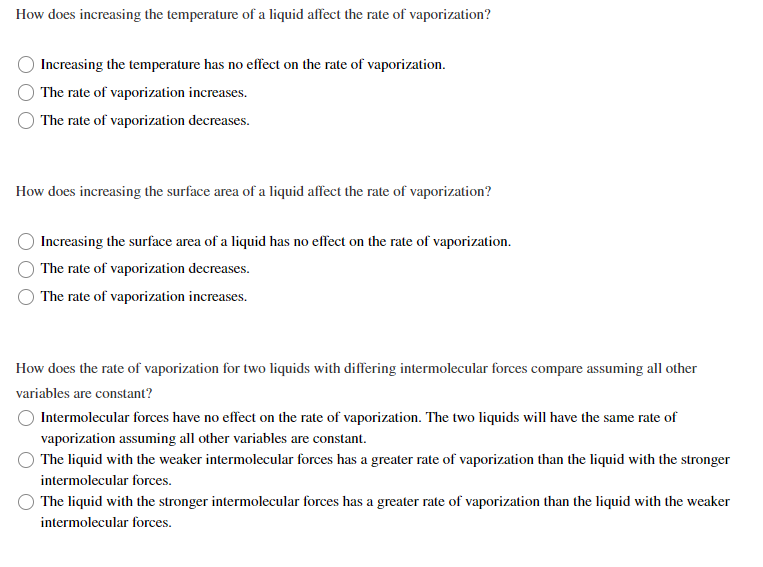How does increasing the temperature of a liquid affect the rate of vaporization? Increasing the temperature has no effect on the rate of vaporization. The rate of vaporization increases. O The rate of vaporization decreases. How does increasing the surface area of a liquid affect the rate of vaporization? Increasing the surface area of a liquid has no effect on the rate of vaporization. O The rate of vaporization decreases. The rate of vaporization increases. How does the rate of vaporization for two liquids with differing intermolecular forces compare assuming all other variables are constant? Intermolecular forces have no effect on the rate of vaporization. The two liquids will have the same rate of vaporization assuming all other variables are constant. O The liquid with the weaker intermolecular forces has a greater rate of vaporization than the liquid with the stronger intermolecular forces. The liquid with the stronger intermolecular forces has a greater rate of vaporization than the liquid with the weaker intermolecular forces.
How does increasing the temperature of a liquid affect the rate of vaporization? Increasing the temperature has no effect on the rate of vaporization. The rate of vaporization increases. O The rate of vaporization decreases. How does increasing the surface area of a liquid affect the rate of vaporization? Increasing the surface area of a liquid has no effect on the rate of vaporization. O The rate of vaporization decreases. The rate of vaporization increases. How does the rate of vaporization for two liquids with differing intermolecular forces compare assuming all other variables are constant? Intermolecular forces have no effect on the rate of vaporization. The two liquids will have the same rate of vaporization assuming all other variables are constant. O The liquid with the weaker intermolecular forces has a greater rate of vaporization than the liquid with the stronger intermolecular forces. The liquid with the stronger intermolecular forces has a greater rate of vaporization than the liquid with the weaker intermolecular forces.
Introductory Chemistry: An Active Learning Approach
6th Edition
ISBN:9781305079250
Author:Mark S. Cracolice, Ed Peters
Publisher:Mark S. Cracolice, Ed Peters
Chapter15: Gases,liquids, And Solids
Section: Chapter Questions
Problem 99E
Related questions
Question

Transcribed Image Text:How does increasing the temperature of a liquid affect the rate of vaporization?
Increasing the temperature has no effect on the rate of vaporization.
The rate of vaporization increases.
O The rate of vaporization decreases.
How does increasing the surface area of a liquid affect the rate of vaporization?
Increasing the surface area of a liquid has no effect on the rate of vaporization.
O The rate of vaporization decreases.
The rate of vaporization increases.
How does the rate of vaporization for two liquids with differing intermolecular forces compare assuming all other
variables are constant?
Intermolecular forces have no effect on the rate of vaporization. The two liquids will have the same rate of
vaporization assuming all other variables are constant.
O The liquid with the weaker intermolecular forces has a greater rate of vaporization than the liquid with the stronger
intermolecular forces.
The liquid with the stronger intermolecular forces has a greater rate of vaporization than the liquid with the weaker
intermolecular forces.
Expert Solution
This question has been solved!
Explore an expertly crafted, step-by-step solution for a thorough understanding of key concepts.
This is a popular solution!
Trending now
This is a popular solution!
Step by step
Solved in 2 steps

Knowledge Booster
Learn more about
Need a deep-dive on the concept behind this application? Look no further. Learn more about this topic, chemistry and related others by exploring similar questions and additional content below.Recommended textbooks for you

Introductory Chemistry: An Active Learning Approa…
Chemistry
ISBN:
9781305079250
Author:
Mark S. Cracolice, Ed Peters
Publisher:
Cengage Learning

Chemistry: Principles and Reactions
Chemistry
ISBN:
9781305079373
Author:
William L. Masterton, Cecile N. Hurley
Publisher:
Cengage Learning

Principles of Modern Chemistry
Chemistry
ISBN:
9781305079113
Author:
David W. Oxtoby, H. Pat Gillis, Laurie J. Butler
Publisher:
Cengage Learning

Introductory Chemistry: An Active Learning Approa…
Chemistry
ISBN:
9781305079250
Author:
Mark S. Cracolice, Ed Peters
Publisher:
Cengage Learning

Chemistry: Principles and Reactions
Chemistry
ISBN:
9781305079373
Author:
William L. Masterton, Cecile N. Hurley
Publisher:
Cengage Learning

Principles of Modern Chemistry
Chemistry
ISBN:
9781305079113
Author:
David W. Oxtoby, H. Pat Gillis, Laurie J. Butler
Publisher:
Cengage Learning

Chemistry: An Atoms First Approach
Chemistry
ISBN:
9781305079243
Author:
Steven S. Zumdahl, Susan A. Zumdahl
Publisher:
Cengage Learning

Chemistry: Principles and Practice
Chemistry
ISBN:
9780534420123
Author:
Daniel L. Reger, Scott R. Goode, David W. Ball, Edward Mercer
Publisher:
Cengage Learning

General Chemistry - Standalone book (MindTap Cour…
Chemistry
ISBN:
9781305580343
Author:
Steven D. Gammon, Ebbing, Darrell Ebbing, Steven D., Darrell; Gammon, Darrell Ebbing; Steven D. Gammon, Darrell D.; Gammon, Ebbing; Steven D. Gammon; Darrell
Publisher:
Cengage Learning